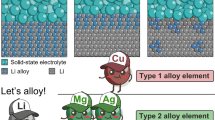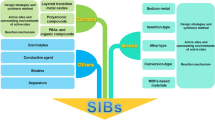Abstract
Choosing a suitable anode material is considered to be very important in developing high-performance batteries. In this study, density functional theory (DFT) computations are done for investigating the potential application of a B3S monolayer as an anode material. As an anode material, the B3S monolayer can be expected to have high performance with a lower potassium (K) diffusion barrier and the open-circuit voltage of the B3S monolayer, which are Ea < 0.37 eV and ∼ 0.19 V respectively. Moreover, its storage capacity is high (1642 mA h g−1). Finally, the metallicity of this monolayer is investigated, showing that the battery operating cycle and electrical conductance are good. Overall, the results reveal that the B3S monolayer can be considered as an encouraging anode material in K-ion batteries.



Similar content being viewed by others
References
Adhikari K, Ray AK (2011) Carbon- and silicon-capped silicon carbide nanotubes: an ab initio study. Phys Lett Sect A Gen Atom Solid State Phys 375(17):1817–1823. https://doi.org/10.1016/j.physleta.2011.03.016
Bashiri S, Vessally E, Bekhradnia A, Hosseinian A, Edjlali L (2017) Utility of extrinsic [60] fullerenes as work function type sensors for amphetamine drug detection: DFT studies. Vacuum 136:156–162. https://doi.org/10.1016/j.vacuum.2016.12.003
Belasfar K, Houmad M, Boujnah M, Benyoussef A, Kenz AE (2020) First-principles study of BC3 monolayer as anodes for lithium-ion and sodium-ion batteries applications. J Phys Chem Solids 139:109319
Bhauriyal P, Mahata A, Pathak B (2018) Graphene-like carbon–nitride monolayer: a potential anode material for Na-and K-ion batteries. J Phys Chem C 122(5):2481–2489
Chan T-L, Chelikowsky JR (2010) Controlling diffusion of lithium in silicon nanostructures. Nano Lett 10(3):821–825
Chen H-Y, Gilles PW (1970) High molecular weight boron sulfides. V. Vaporization behavior of the boron-sulfur system. J Am Chem Soc 92(8):2309–2312
Chodvadiya D, Som NN, Jha PK, Chakraborty B (2021) Enhancement in the catalytic activity of two-dimensional α-CN by B, Si and P doping for hydrogen evolution and oxygen evolution reactions. Int J Hydrogen Energy 46(43):22478–22498
Conrad O, Jansen C, Krebs B (1998) Boron-sulfur and boron-selenium compounds—from unique molecular structural principles to novel polymeric materials. Angew Chem Int Ed 37(23):3208–3218
Dahn JR, Zheng T, Liu Y, Xue J (1995) Mechanisms for lithium insertion in carbonaceous materials. Science 270(5236):590–593
Dolui K, Quek SY (2015) Quantum-confinement and structural anisotropy result in electrically-tunable dirac cone in few-layer black phosphorous. Sci Rep 5:11699. https://doi.org/10.1038/srep11699
Du J, Sun X, Jiang G (2010) Structures, chemical bonding, magnetisms of small Al-doped zirconium clusters. Phys Lett Sect A Gen Atom Solid State Phys 374(6):854–860. https://doi.org/10.1016/j.physleta.2009.12.009
Dubal DP, Ayyad O, Ruiz V, Gomez-Romero P (2015) Hybrid energy storage: the merging of battery and supercapacitor chemistries. Chem Soc Rev 44(7):1777–1790
Eftekhari A (2017) Low voltage anode materials for lithium-ion batteries (review). Energy Storage Mater 7:157–180. https://doi.org/10.1016/j.ensm.2017.01.009
Gao J, Tang M, Zhang X, Yang G (2022) Conductive C3NS monolayer with superior properties for K ion batteries. J Phys Chem Lett 13(51):12055–12060
Geim AK, Novoselov KS (2007) The rise of graphene. Nat Mater 6(3):183–191. https://doi.org/10.1038/nmat1849
Goodenough JB, Park K-S (2013) The Li-ion rechargeable battery: a perspective. J Am Chem Soc 135(4):1167–1176
Grimme S (2004) Accurate description of van der Waals complexes by density functional theory including empirical corrections. J Comput Chem 25(12):1463–1473. https://doi.org/10.1002/jcc.20078
Guo B, Liu Q, Chen E, Zhu H, Fang L, Gong JR (2010) Controllable N-doping of graphene. Nano Lett 10(12):4975–4980
Hankel M, Searles DJ (2016) Lithium storage on carbon nitride, graphenylene and inorganic graphenylene. Phys Chem Chem Phys 18(21):14205–14215. https://doi.org/10.1039/c5cp07356a
Hankel M, Ye D, Wang L, Searles DJ (2015) Lithium and sodium storage on graphitic carbon nitride. J Phys Chem C 119(38):21921–21927
Hou H, Qiu X, Wei W, Zhang Y, Ji X (2017) Carbon anode materials for advanced sodium-ion batteries. Adv Energy Mater 7(24):1602898
Hwang HJ, Koo J, Park M, Park N, Kwon Y, Lee H (2013) Multilayer graphynes for lithium ion battery anode. J Phys Chem C 117(14):6919–6923. https://doi.org/10.1021/jp3105198
Jacobson MZ (2009) Review of solutions to global warming, air pollution, and energy security. Energy Environ Sci 2(2):148–173
Jana S, Thomas S, Lee CH, Jun B, Lee SU (2019) B 3 S monolayer: prediction of a high-performance anode material for lithium-ion batteries. J Mater Chem A 7(20):12706–12712
Jeong G, Kim Y-U, Kim H, Kim Y-J, Sohn H-J (2011) Prospective materials and applications for Li secondary batteries. Energy Environ Sci 4(6):1986–2002
Jian Z, Luo W, Ji X (2015) Carbon electrodes for K-ion batteries. J Am Chem Soc 137(36):11566–11569
Joshi RP, Ozdemir B, Barone V, Peralta JE (2015) Hexagonal BC3: a robust electrode material for Li, Na, and K ion batteries. J Phys Chem Lett 6(14):2728–2732
Komaba S, Hasegawa T, Dahbi M, Kubota K (2015) Potassium intercalation into graphite to realize high-voltage/high-power potassium-ion batteries and potassium-ion capacitors. Electrochem Commun 60:172–175
Ling C, Mizuno F (2014) Boron-doped graphene as a promising anode for Na-ion batteries. Phys Chem Chem Phys 16(22):10419–10424
Liu C, Neale ZG, Cao G (2016) Understanding electrochemical potentials of cathode materials in rechargeable batteries. Mater Today 19(2):109–123
Liu X, Zhu B, Gao Y (2016) Structure stability of TiAu4 nanocluster with water adsorption. Phys Lett Sec A Gen Atom Solid State Phys 380(22–23):1971–1975. https://doi.org/10.1016/j.physleta.2016.04.012
Luo W, Wan J, Ozdemir B, Bao W, Chen Y, Dai J et al (2015) Potassium ion batteries with graphitic materials. Nano Lett 15(11):7671–7677
Mendoza-Sánchez B, Gogotsi Y (2016) Synthesis of two-dimensional materials for capacitive energy storage. Adv Mater 28(29):6104–6135
Mikhaleva NS, Visotin MA, Kuzubov AA, Popov ZI (2017) VS2/graphene heterostructures as promising anode material for Li-ion batteries. J Phys Chem C 121(43):24179–24184
Nitta N, Wu F, Lee JT, Yushin G (2015) Li-ion battery materials: present and future. Mater Today 18(5):252–264
Nobuhara K, Nakayama H, Nose M, Nakanishi S, Iba H (2013) First-principles study of alkali metal-graphite intercalation compounds. J Power Sources 243:585–587
Pan H, Hu Y-S, Chen L (2013) Room-temperature stationary sodium-ion batteries for large-scale electric energy storage. Energy Environ Sci 6(8):2338–2360
Park M-H, Kim MG, Joo J, Kim K, Kim J, Ahn S et al (2009) Silicon nanotube battery anodes. Nano Lett 9(11):3844–3847
Peyghan AA, Tabar MB, Yourdkhani S (2013) A theoretical study of OH and OCH<inf>3</inf> free radical adsorption on a nanosized tube of BC<inf>2</inf>N. J Cluster Sci 24:1–10
Raccichini R, Varzi A, Passerini S, Scrosati B (2015) The role of graphene for electrochemical energy storage. Nat Mater 14(3):271–279
Schmidt MW, Baldridge KK, Boatz JA, Elbert ST, Gordon MS, Jensen JH et al (1993) General atomic and molecular electronic structure system. J Comput Chem 14(11):1347–1363. https://doi.org/10.1002/jcc.540141112
Sergeeva AP, Piazza ZA, Romanescu C, Li W-L, Boldyrev AI, Wang L-S (2012) B22–and B23–: all-boron analogues of anthracene and phenanthrene. J Am Chem Soc 134(43):18065–18073
Sergeeva AP, Zubarev DY, Zhai H-J, Boldyrev AI, Wang L-S (2008) A photoelectron spectroscopic and theoretical study of B16− and B162−: an all-boron naphthalene. J Am Chem Soc 130(23):7244–7246
Tang M, Wang C, Schwingenschlögl U, Yang G (2021) BC6P Monolayer: isostructural and isoelectronic analogues of graphene with desirable properties for K-Ion batteries. Chem Mater 33(23):9262–9269
Tarascon J-M, Armand M (2011) Issues and challenges facing rechargeable lithium batteries. Materials for sustainable energy: a collection of peer-reviewed research and review articles from Nature Publishing Group. World Scientific, Singapore, pp 171–179
Trancik JE (2014) Renewable energy: back the renewables boom. Nature 507(7492):300–302
Ugeda MM, Bradley AJ, Shi SF, da Jornada FH, Zhang Y, Qiu DY et al (2014) Giant bandgap renormalization and excitonic effects in a monolayer transition metal dichalcogenide semiconductor. Nat Mater 13(12):1091–1095. https://doi.org/10.1038/nmat4061
Winter M, Besenhard JO, Spahr ME, Novak P (1998) Insertion electrode materials for rechargeable lithium batteries. Adv Mater 10(10):725–763
Zhang X, Hou L, Ciesielski A, Samorì P (2016) 2D materials beyond graphene for high-performance energy storage applications. Adv Energy Mater 6(23):1600671
Zhao Z, Yu T, Zhang S, Xu H, Yang G, Liu Y (2019) Metallic P3C monolayer as anode for sodium-ion batteries. Journal of Materials Chemistry A 7(1):405–411
Funding
Not applicable.
Author information
Authors and Affiliations
Corresponding authors
Ethics declarations
Conflict of interest
Not applicable.
Ethical approval
Not applicable.
Informed consent
Not applicable.
Rights and permissions
Springer Nature or its licensor (e.g. a society or other partner) holds exclusive rights to this article under a publishing agreement with the author(s) or other rightsholder(s); author self-archiving of the accepted manuscript version of this article is solely governed by the terms of such publishing agreement and applicable law.
About this article
Cite this article
Alali, R., Ismael, T.N., Rajab, W.J. et al. Application of B3S Monolayer as a Promising Anode in K-Ion Batteries. Chemistry Africa (2024). https://doi.org/10.1007/s42250-024-00906-5
Received:
Accepted:
Published:
DOI: https://doi.org/10.1007/s42250-024-00906-5




